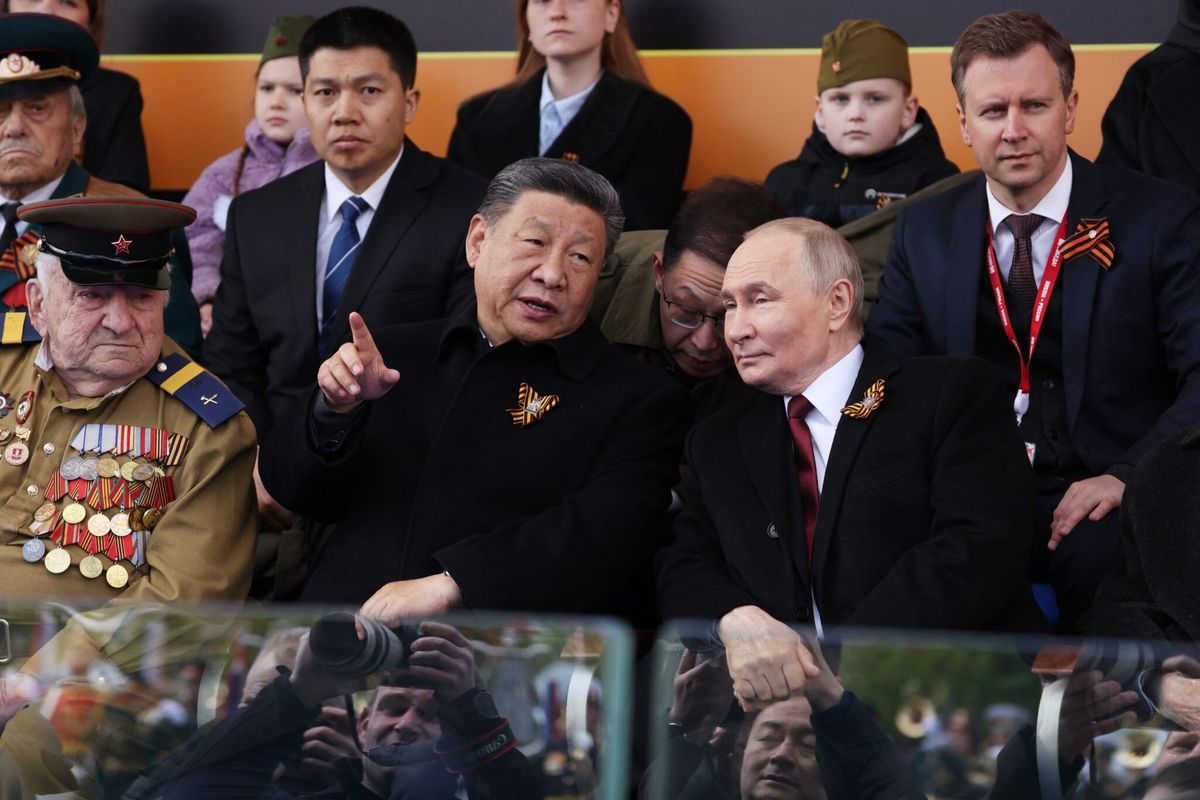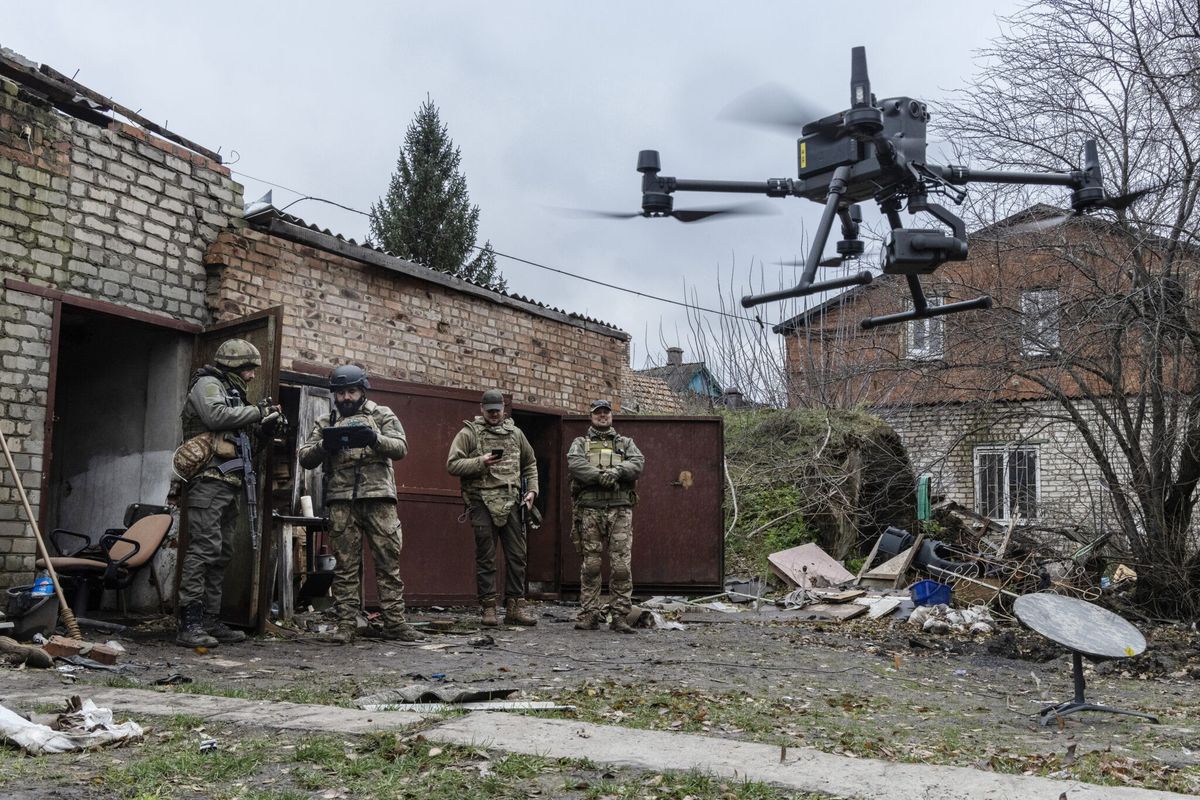SUBSCRIBER+ EXCLUSIVE REPORTING - A weaponized drone sinks a Russian warship on the Black Sea. A series of drone attacks strike oil facilities inside Russia. And drone weapons worth roughly $5,000 burn down a warehouse in eastern Ukraine, destroying Russian tanks and other weapons worth millions of dollars.
Those are just three recent episodes in what has become a daily feature of Ukraine’s resistance against Russia, and two years after the invasion, the drone war is one of the few theaters in which the Ukrainians have notched regular victories. The destruction of the Russian warehouse this week, in the eastern village of Staronlynivka, reportedly took out a pair of T-72 tanks and several other valuable armored vehicles. The strike in the Black Sea, meanwhile, marked the second time in less than a month that a Ukrainian drone attack destroyed a Russian warship.
On the more traditional frontlines, Ukraine is suffering. Last week, for the first time in more than a year, the Russians captured a city – the small and beleaguered Avdiivka – and there are fears that the battle there may presage a broader Russian advance. But the war in Ukraine is being fought in many places, and in many ways. And when it comes to drone weaponry, Ukraine is bringing both ingenuity and sheer volume to the battle.
Earlier this month, Ukrainian President Volodymyr Zelensky referred to the Black Sea successes in announcing the creation of a drone-centric military branch, the Unmanned Systems Forces, along with a goal of producing more than one million Ukrainian drones in 2024.
“Drones — unmanned systems — have proven their effectiveness in battles on land, in the sky and at sea,” Zelensky said. “Ukraine has truly changed the security situation in the Black Sea with the help of drones.”
Dr. Stacy Pettyjohn, defense program director at the Center for a New American Security (CNAS), wrote in a just-published study that the drone war in Ukraine has brought about “rapid cycles of tactical innovation” that – beyond the current conflict, “could truly revolutionize warfare.”
What’s less clear is whether a major Ukrainian push to build and utilize large numbers of drone weapons can alter the course of the war.
Short-range, Long-range and Off-the-shelf
If the conflict in Ukraine is the world’s first true “drone war”, it’s also showcasing a huge variety of the airborne weapons and some seaborne variants as well. The Ukrainian arsenal now features dozens of models, from off-the-shelf drones to highly sophisticated versions that can travel long distances and cause significant damage to Russian assets.
For Ukraine, the technology provided a head start. In 2014, following Russia’s invasion of the Donbas region in Eastern Ukraine, Ukrainian civilians created Aerorozvidka, a volunteer enterprise devoted to taking commercial or home-made drones and retrofitting them for combat. By the time Vladimir Putin ordered the full-scale invasion of Ukraine in 2022, Aerorozvidka had moved from a retrofitting approach to building drone weapons from scratch. Aerorozvidka’s work also meant that by the time Russian forces rolled in, Ukraine had a significant number of experienced drone operators ready to work with the Ukrainian military.
Ukraine also got an early gift from Turkey, in the form of dozens of the Turkish-made Bayraktar TB2 drones that were delivered soon after the invasion. As Pettyjohn notes, “the TB2 was one of the few armed military drones that Ukraine had at the war’s start, and the only one that carried precise laser-guided bombs.” The Bayraktar was so successful against Russian armored vehicles in 2022 that the word - “Bayraktar” - became a symbol of the Ukrainian resistance and was found on t-shirts and in popular memes. Earlier this month, the Turkish firm behind the TB2 drones, announced a 12-month project to build a manufacturing plant outside Kyiv.
But the made-in-Ukraine arsenal has grown as well – from small models used to harass Russian forces in close-quarter fighting (the Leleka-100, Furia, and PD-1 among them), and longer-range models (the UJ-22 Bober, Morok, and Mugin-5) that have traveled hundreds of miles to reach fixed targets, including some inside Russia. The latter versions have been responsible for strikes against Russian oil facilities and weapons depots.
The current workhorse of the Ukrainian drone fleet is a far less sophisticated model – but deadly nonetheless. It’s known as the “FPV,” for “First Person View,” named for its main feature: an FPV offers the drone operator a small screen and real-time video to guide the drone into nooks and crannies before detonating. The FPV cannot travel long distances, but it’s cheap to make, easy to use, and if the enemy is nearby, it can be a devastating weapon.
A recent Washington Post piece on the battle for Avdiivka described a Ukrainian special forces unit conducting aerial reconnaissance over the city, and using an FPV once Russian soldiers were spotted. “Vitamin [a drone operator’s call sign] tracked a group of Russians entering a house and then waited for them to exit. Three ran out. Directing the drone while wearing goggles that gave him the camera’s view, Vitamin descended and landed between two, likely wounding both men,” according to the report.
The Made-in-Ukraine drone industry
While Ukrainians wait anxiously for news from Washington about the future of U.S. military aid, the country is moving at a rapid pace to scale its own domestic drone industry.
That’s the idea behind Zelensky’s new drone initiative, and it’s a large part of the portfolio of Ukraine’s 33-year-old Minister of Digitial Transformation, Mykhailo Fedorov.
In a recent review of the made-in-Ukraine drone effort, Fedorov ticked off a series of metrics: more than a dozen startup companies working on drone weapons production; more than $20 million in new financing; and more than 20,000 Ukrainian civilians newly trained as drone operators. In addition to Zelensky’s call for a million new drones in 2024, Fedorov says the country is on track to produce thousands of longer-range FPV’s this year, capable of reaching Russian targets as far as 600 miles away. “Two years ago,” Fedorov told Reuters, “this category (of FPV’s) did not exist."
Part of the effort involves making private-sector manufacturing easier; the government is ending a state monopoly on drone design and fabrication, and producing component parts domestically, chipping away at the country’s dependence on foreign sources, including China.
“We need to act in an anti-bureaucratic way,” Fedorov said. “This is the essence of a breakthrough in the war of technology.”
Bryan Clark, a senior fellow and director of the Center for Defense Concepts and Technology at the Hudson Institute, praised Ukraine’s drone plans in an interview with The Cipher Brief. “A growing number of private-sector drone production companies are cropping up in Ukraine,” Clark said. He added that the country’s efforts show “how rapidly the Ukrainian miliary is transitioning from a Cold War Soviet-style armor and artillery force to one that relies on precision weapons, commercial satellite communications and sensing, and unmanned systems.”
Ukraine will still be happy for outside help. This week, Canada announced the shipment of 800 military-grade drones to Ukraine, and earlier this month NATO defense ministers described a new initiative to supply Ukraine with one million drones within a year. At perhaps the most sophisticated end of the drone spectrum, the U.S. and U.K. have pledged to deliver AI-enabled drones to Ukraine, weapons which some analysts believe may may do more than any others to mitigate Russia’s overwhelming advantage in ammunition. Adm. Rob Bauer, chairman of NATO’s military committee, said the use of these smart drones could be “more successful than artillery barrages over Russians.”
Up in the Air – and Under the Sea
The number of Ukrainian seaborne drones is far lower, but they have done considerable damage in a short time.
As Cipher Brief experts assess the state of the war at the two-year mark, they note that strikes against the vaunted and valuable Russian Black Sea Fleet have been an important strategic success – and that success has come largely thanks to the maritime version of the drone weapon.
It was a sea drone that sunk the Caesar Kunikov, a Russian warship, last week, an attack that followed another sinking of a Russian vessel in the Black Sea in January. According to Ukraine’s intelligence directorate, domestically produced Magura V5 unmanned drones, which are capable of speeds up to 36 knots, were used in the Kunikov attack.
Pettyjohn notes that Ukraine’s sea drones, along with anti-ship cruise missiles, are a “very real threat” to Russian naval forces and have helped open crucial Ukrainian commercial shipping lanes as well. “The net use of the drones and the anti-ship cruise missiles has been really significant in terms of enabling Ukraine to keep its ports open and to continue to export grain, which is a critical part of its economy,” Pettyjohn said, amounting to a “sort of an outsized effect for some fairly asymmetric capabilities.”
Former CIA Director Gen. David Petraeus agrees. Ukraine’s “maritime drones have forced the Russians to withdraw from the important port of Sevastopol in occupied Crimea for the first time in a couple of centuries,” he told The Cipher Brief, and they have damaged at least one third of Russia’s vaunted Black Sea Fleet.
“These are largely irreplaceable for Russia,” Petraeus said. “That’s a very significant achievement.”
Clark points to another advantage maritime drones afford Ukraine – their mobility and flexibility, via remote control, make them far more effective than conventional sea mines, and afford Ukrainians the ability to “bottle up the Russian fleet without impacting the shipping lanes.”
Can Drones win the war?
Fedorov is publicly bullish on the impact drones can have in the next year of war. In the recent Reuters interview he put it bluntly: “This technology can really save us.”
No doubt the operational impact of drones on day-to-day combat has been substantial – extending the view of entrenched forces, minimizing troop exposure while conducting perilous scouting and targeting missions, and carrying out successful strikes against a variety of targets. And Gen. Petraeus and others believe the Black Sea strikes in particular can make a difference.
But there is skepticism as to whether the Ukrainian drone arsenal – however much it grows – can change the outcome of the war.
Part of the problem is that the Russians have their own arsenal. As the Post pointed out in its dispatch from Avdiivka, “the Russians have FPVs, too — and more of them — largely entrenching both forces, who fear that even a single soldier walking around will be targeted.”
The Kremlin runs its own state drone production operation, and Russia has received thousands of powerful and highly sophisticated Shahed and Mohajer drones from Iran.
“I think Russia is producing more of these FPV’S right now than Ukraine is,” CNAS’ Pettyjohn told The Cipher Brief. “Ukraine has innovated at every level in terms of using commercial tech, building drones, building them from commercial sub-components. They came up with the FPV commercial concept, but Russia has been able to emulate it and then they had a greater capacity to mass produce and that's where Ukraine is currently disadvantaged.”
Paul Lushenko, an assistant professor and director of special operations at the Army War College, believes “drones have not, and are not likely to, shape the outcome of the war in Ukraine. They have not allowed Ukraine to break its stalemate with Russia, nor have they encouraged Russia to end its occupation of Ukraine.”
Lushenko says Ukraine’s drones will continue to have impact in their targeting of tanks, armored personnel carriers and the occasional wearship, but he doubts they can move the needle in a bigger way.
“The lesson from Ukraine is that while drones have some value at the tactical and operational levels of war, they are strategically inconsequential. They are not a magic bullet, offering a game-changing capability to decide the fate of nations.”
Read more expert-driven national security insights, perspective and analysis in The Cipher Brief












